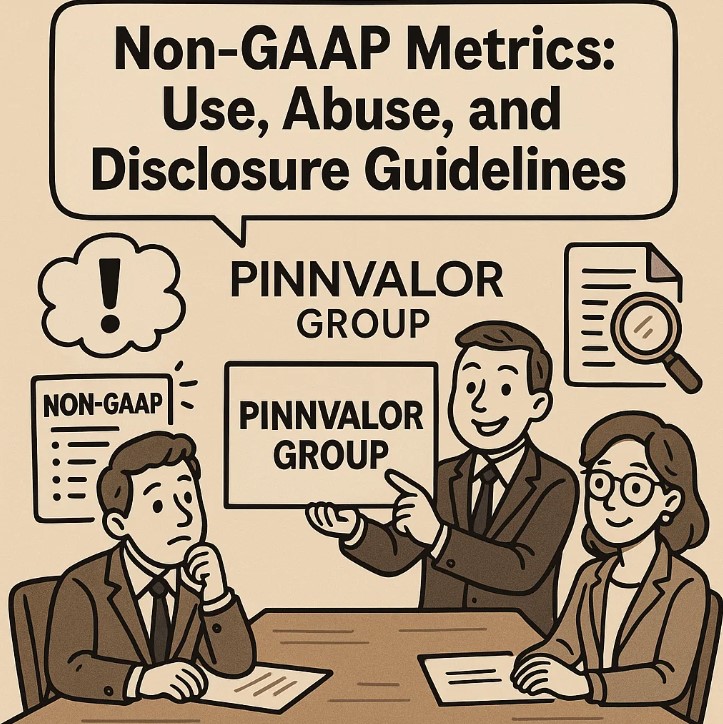
Non-GAAP Metrics: Use, Abuse, and Disclosure Guidelines
In the realm of corporate financial reporting, companies frequently supplement their standard GAAP (Generally Accepted Accounting Principles) financial statements with Non-GAAP metrics. These measures can offer investors and analysts additional insight into a company’s financial health, operational efficiency, and future prospects. However, because Non-GAAP metrics are not governed by standardized rules, they present both opportunities and risks—ranging from enhanced transparency to potential misuse and investor confusion.
This blog dives deep into the nature of Non-GAAP metrics, their legitimate uses, common abuses, and the regulatory landscape governing their disclosure.
When do Non-GAAP adjustments cross the line from insight to abuse?
Non-GAAP metrics offer valuable perspective beyond GAAP, but their power lies in ethical use and clear disclosure.
What Are Non-GAAP Metrics?
GAAP provides a standardized framework for preparing financial statements, ensuring consistency, comparability, and reliability. Non-GAAP metrics, however, are financial measures that adjust or exclude certain line items found in GAAP results. These items often include one-time charges, restructuring expenses, stock-based compensation, or other non-cash and unusual costs.
Common examples of Non-GAAP metrics include:
- EBITDA (Earnings Before Interest, Taxes, Depreciation, and Amortization)
- Adjusted Earnings or Adjusted Net Income
- Free Cash Flow
- Core Operating Earnings
Since these metrics are not regulated under GAAP, companies define and calculate them differently, making them flexible but sometimes inconsistent.
Why Do Companies Use Non-GAAP Metrics?
- Better Reflect Operational Performance: GAAP results can be skewed by non-recurring or non-operational items. By excluding such items, companies aim to provide a clearer picture of their ongoing business performance.
- Meet Investor Demand for Insight: Investors often want to focus on a company’s sustainable profitability and cash generation rather than one-off or non-cash charges.
- Industry Benchmarking: In some industries, certain Non-GAAP metrics are widely used benchmarks, helping investors compare companies more effectively.
- Manage Market Expectations: Non-GAAP metrics can smooth out earnings volatility and help companies communicate their growth story more clearly.
Potential for Abuse and Risks
While Non-GAAP metrics can enhance understanding, their flexibility also opens doors for misuse:
- Excluding Recurring Expenses: Companies might exclude regular costs as “non-recurring” to artificially inflate profitability.
- Inconsistent Definitions: Without standardized calculation methods, companies may manipulate metrics to suit narratives.
- Overemphasis on Non-GAAP Figures: Presenting Non-GAAP metrics more prominently than GAAP results can mislead investors.
- Cherry-Picking Adjustments: Highlighting only favorable adjustments while ignoring unfavorable ones.
Such practices can distort a company’s true financial condition and undermine investor trust.

Regulatory Framework and Disclosure Guidelines
Recognizing the risks, regulatory bodies like the U.S. Securities and Exchange Commission (SEC) have established guidelines to govern Non-GAAP disclosures:
Key Requirements Include:
- Reconciliation: Companies must reconcile Non-GAAP measures with the closest GAAP equivalent, detailing all adjustments clearly.
- No Greater Prominence: Non-GAAP results should never be displayed more prominently than GAAP figures.
- Consistent Application: Companies should use consistent definitions for Non-GAAP metrics over time or disclose changes transparently.
- Avoid Misleading Presentation: Adjustments should be reasonable and not exclude costs that are expected to recur.
Best Practices for Companies
- Be Transparent: Fully explain the rationale behind every adjustment and how Non-GAAP metrics are calculated.
- Maintain Consistency: Use the same definitions across reporting periods unless changes are necessary and disclosed.
- Provide Context: Clarify the usefulness and limitations of Non-GAAP measures for investors.
- Avoid Overuse: Limit adjustments to meaningful items that truly enhance understanding of performance.
- Align with Operational Reality: Ensure that the metrics reflect the company’s ongoing business conditions.
Conclusion
Non-GAAP metrics are valuable tools that can provide additional insight into a company’s performance beyond GAAP financials. However, their lack of standardization and potential for manipulation demand careful scrutiny by investors and disciplined disclosure by companies.
When used responsibly and transparently, Non-GAAP metrics can enhance financial communication and investor understanding. Conversely, misuse can damage credibility and mislead stakeholders.
As an investor, always evaluate Non-GAAP metrics alongside GAAP results and seek clear disclosures. As a company, adhere to regulatory guidelines and prioritize transparency to build and maintain trust.
